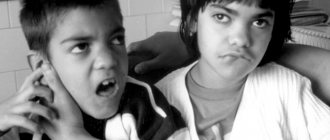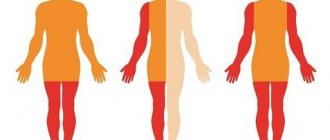Mental retardation (oligophrenia) - symptoms and treatment
First of all, a thorough examination of the mother should be carried out during the prenatal period to identify chromosomal pathologies:
- from the anamnesis it is necessary to find out all the chronic diseases of the pregnant woman, her hereditary predisposition, bad habits, previous diseases and operations;
- it is necessary to investigate the Rh compatibility of mother and child;
- do clinical blood and urine tests to exclude HIV infection, hepatitis, sexually transmitted infections, influenza, herpes and other diseases;
- conduct ultrasound diagnostics, which allows you to identify fetal abnormalities;
- examine α-fetoprotein - its increase in the mother’s blood is an indication for studying the amniotic fluid for the content of α-fetoprotein;
- According to indications, cells in the amniotic fluid are examined.
After the birth of a child, in the first days and years of his life, general blood and urine tests, biochemical tests are carried out, and various screening tests are used to identify metabolic disorders (phenylketonuria, tyrosinemia, mucopolysaccharidosis, histidinemia and others).
Among the instrumental diagnostic methods used:
- X-ray examination of the skull;
- electroencephalography (EEG);
- computer and magnetic resonance imaging (CT and MRI);
- echoencephaloscopy (EchoEG);
- karyotyping;
- rheoencephalography.[7][12]
Among psycho-pedagogical research methods, various tests are used to determine the level of intelligence (depending on the age of the child), as well as diagnostic tests to study the general mental development of the child.
From the age of two, the Stanford-Binet Intelligence Scale is used. It estimates the intelligence quotient (IQ) of the person being tested. The test consists of four parts, which examine:
- verbal skills;
- computing skills;
- abstract visual skills;
- short-term memory.
This is not just “dry” testing; during the research process, the specialist can observe the manifestation of various qualities of the test subject (concentration, perseverance, diligence, self-confidence), which is also noted in the results.
From the age of five in Russia, the Wechsler test is most often used.
Important : IQ results in this test do not correlate directly with IQ scores for classification in ICD-10. You should subtract 10 from the result in the Wechsler test and only then turn to ICD-10 to make a diagnosis. For example, if the result is 34, then we subtract 10 and get IQ = 24, which corresponds to F72 - a severe form of mental retardation.
The test consists of verbal and non-verbal parts, which are divided by topic (arithmetic, vocabulary, memorizing numbers, missing parts, Koos cubes, folding figures, etc.).
When processing the results:
- general intelligence scores are calculated;
- coefficients are calculated based on completed subtests;
- the individual behavioral profile of the subject is interpreted.
In addition to the above tests, there are a large number of alternative methods:
- Raven's method;
- Knobloch method;
- Bayley Developmental Scale;
- Bender Gestalt test;
- Denver screening method and others.[1][4]
Differential diagnosis
Differential diagnosis is carried out with the following pathologies:
- Schizophrenia with onset in childhood
Children with this disease are characterized by normal intellectual development in the first years of life. They may have a rich vocabulary, they show interest in many issues, and often fantasize. There are no speech disorders, but if they arise, it is not due to disorders of general mental development, but due to deformation of thinking.
Characteristic is the increase in hypobulia and hypothymia: if at first the child was interested in the world and showed a lot of vivid emotions, then he gradually becomes unprincipled, lacking initiative, and detached.
When completing tasks and tests, children with schizophrenia show instability in their results. They are able to answer difficult questions and fail easy tests. These children are prone to generalization, if particular characteristics are not taken into account, while with UL the child cannot complete the task in a generalized manner.
- Autism
Approximately 70% of people with autism have features of ID. However, autism should be diagnosed first, since the methods of correction for children with ID and autism are different.
Unlike people with mental retardation, children with autism are characterized by uneven mental development delays. Moreover, the delay is observed only in certain areas of the psyche, but otherwise mental development corresponds to the norm. With oligophrenia, general mental underdevelopment is observed.
- Mental retardation (MDD)
This deviation is a state of mild intellectual underdevelopment, when the level of thinking or the emotional-volitional sphere and speech function do not correspond to age. Unlike UO, it can be reversible, but if this does not happen by the age of 13, then a diagnosis of mild debility is made.
ZPR occurs under the influence of hereditary factors, external hazards (traumatic brain injury, organic brain damage, disruption of the sensory organs) and psychogenic influences (pedagogical neglect, lack of proper care and education). Children with mental retardation, unlike children with mental retardation, are more emotional, interested in the world around them, have a good imagination, and are more learnable.[7]
- Dementia
It is important not to confuse mental retardation and dementia, which is also characterized by dementia and other similar mental disorders. However, dementia is a state of degradation, that is, a transition from a normal mental state to a pathological one, while the psyche of a person with ID did not initially develop. Therefore, to make a diagnosis, it is necessary to take into account the age at which the pathology arose.[12]
General information
Mental retardation is a congenital or acquired condition in early childhood (up to 3 years) of general underdevelopment of the psyche with a pronounced lack of intellectual abilities.
Mental retardation can be caused by various etiological and pathogenetic factors acting during intrauterine development, childbirth or in the first years of life. In most cases, mental retardation is not a painful process, but a pathological condition, the result of harmfulness that once acted, and has no tendency to progress.
For a long time, the generally accepted term for denoting states of mental retardation was the term “oligophrenia” (Greek: oligos - small, phren - mind, i.e. dementia), which was proposed by E. Kraepelin (1915) to distinguish the congenital dementia he designated from acquired dementia (dementia).
DEBILITY OR MILD FORM
With debility, the least damage to the central nervous system is observed; this form of retardation is relatively mild. Children are able to pronounce small phrases, they are very observant and stubborn, their distinctive feature is their inability to deceive.
Debility can be of several types:
- uncomplicated debility. This condition is characterized by a lag only in intellectual development. There are no serious deviations in the emotional and volitional sphere;
- with complications in the form of disruption of analyzers. Characterized by secondary deviations;
- complications in the form of neurodynamic disorders. The pathology is accompanied by increased fatigue and poor coordination and develops after damage to the cerebral cortex;
- Frontal insufficiency, as a complication of debility, leads to the fact that the child’s arms become flaccid. He is generally unable to navigate in space, and his behavior becomes unmotivated;
- psychopathic behavioral forms lead to underdevelopment of all personal qualities. This is the most severe form of pathology.
Children with retardation are capable of learning in a regular school, but auxiliary programs and special techniques are used. During correctional and educational classes, children are able to learn to count, write and read, and they also acquire the simplest knowledge about the world around them and acquire the simplest work skills.
CAUSES
Intellectual disability is the result of genetic diseases and many other factors, or rather, their combination: behavioral, biomedical, social, educational.
| Causes | Factors | |||
| biomedical | social | behavioral | educational | |
| Intrauterine development of the fetus (prenatal) | -age of parents; - diseases in the mother; -chromosomal disorders; -congenital syndromes | the mother's miserable existence, she was subjected to violence, was poorly fed, did not have access to medical services | parents used alcohol, tobacco, drugs | parents are not prepared for the birth of a child, are cognitively incompetent |
| Birth of a child (perinatal) | -prematurity; - birth injuries | poor baby care | child abandonment | lack of medical supervision |
| Later life (postnatal) | -bad Education; -brain injuries; -degenerative diseases; -epilepsy; -meningoencephalitis | -poverty; -poor family relationships | -domestic violence, harshness towards the child, isolation; -failure to comply with safety measures; -bad behavior | -poor quality medical care and late diagnosis of diseases; -lack of education; -lack of support from other family members |
No one can accurately name the specific “culprits,” even despite fairly scrupulous research and early diagnosis. But, if you analyze the table, the most likely cause of oligophrenia may be:
- any genetic failures - gene mutations, their dysfunction, chromosomal abnormalities;
- hereditary developmental disorders;
- malnutrition;
- infectious diseases of the mother during pregnancy - syphilis, rubella, HIV, herpes, toxoplasmosis, etc.;
- premature birth;
- problematic childbirth - asphyxia, mechanical injuries, hypoxia, fetal asphyxia;
- insufficient upbringing of the child from birth, parents devoted little time to him;
- toxic effects on the fetus leading to brain damage - parental use of strong drugs, drugs, alcoholic beverages, smoking. This also includes radiation;
- infectious diseases of the child;
- skull injury;
- diseases affecting the brain - encephalitis, whooping cough, meningitis, chicken pox;
- drowning.
SYNDROMES COMBINED WITH DIFFERENT DEGREES OF IR
Down syndrome is the most common genetic cause of intellectual disability. It is caused by a chromosomal abnormality - if normally there are 46 of them, then in this case there is an unpaired 47th chromosome. People with this syndrome can be identified by an abnormally short skull, flat face, short arms and legs, short stature, and small mouth. They process the information received poorly and remember it, they lack the concept of time and space, and their speech is poor. Moreover, such individuals adapt well to society.
Martin-Bell syndrome (fragile X chromosome). The second most common genetic cause of mental retardation. It is recognized by the following external features: increased mobility of joints, an elongated face, an enlarged chin, a high forehead, large, protruding ears. They start talking late, but poorly, or don’t speak at all. They are very shy, hyperactive, inattentive, constantly moving their hands and biting them. Men have more cognitive impairment in this category than women.
Williams syndrome (“elf face”). It occurs as a result of hereditary chromosomal rearrangement, the loss of genes in one of them. The patients have a very interesting appearance: the face is narrow and long, blue eyes, flat nose, large lips. Usually suffer from cardiovascular diseases. Rich vocabulary, good memory, excellent musical abilities, and social interaction skills. But there are problems with psychomotor skills.
Angelman syndrome (happy doll or Parsley). Caused by a change in chromosome 15. Very light eyes with characteristic spots on the iris and hair, the head is small, the chin is pushed forward, the mouth is large, the teeth are sparse and long. Severe delay in psychomotor development, significant impairment of speech and movement (poor balance, walks on stiff legs). He often smiles and even laughs for no reason.
Prader-Willi syndrome . It is characterized by the absence of a paternal copy of chromosome 15 and a number of other disorders. He is short in stature, has small arms and legs, suffers from compulsive overeating, and, as a result, obesity. Problems with short-term memory, speech, information processing.
Lejeune's syndrome (cry of the cat or 5p syndrome). A very rare and serious disease caused by the absence of the short arm of chromosome 5. The head is small, the face is round, the lower jaw is underdeveloped and the bridge of the nose is wide, so the eyes are located far from each other. The feet are turned out, the hands are small. The larynx is underdeveloped, there are vision problems, in particular, strabismus. She often cries and makes a sound similar to a kitten meowing. Motor development is delayed, and the ability to pay attention is limited.
In addition to the syndromes mentioned, intellectual disability can coexist with cerebral palsy, deafness and blindness, autistic disorders, epilepsy and other somatic and mental illnesses.
Literature
- Bukhanovsky A. O., Kutyavin Yu. A., Litvak M. E. General psychopathology. A manual for doctors. 2nd ed. - Rostov-on-Don: Phoenix, 1998.
- Zharikov N. M., Tyulpin Yu. G. Psychiatry. - M.: Medicine, 2000. - ISBN 5-225-04189-2.
- Zharikov N. M., Ursova L. G., Khritinin D. V. Psychiatry. - M.: Medicine, 1989.
- Korkina M.V., Lakosina N.D., Lichko A.E., Sergeev I.I. Psychiatry. 2nd ed. - M.: MEDpress-inform, 2002.
- Manual of Psychiatry. Ed. G. V. Morozova. In 2 vols. - M.: Medicine, 1988.
- Boykov, D.I. Communication of children with developmental problems: Communicative differentiation of personality. - St. Petersburg, 2005. - 150 p.
- Vechkanova I. G. Theatrical games in habilitation of preschool children with intellectual disabilities: Educational and methodological manual. - St. Petersburg: KARO, 2006. - 144 p.
- Study, training and education of children with profound intellectual disabilities: Collection of scientific papers. Ed. A. R. Mallera, G. V. Tsikoto. Vol. III. - M., 1978. - 100 p.
- Tiganov, A. S., Snezhnevsky A. V., Orlovskaya D. D. and others. Guide to Psychiatry / Ed. A. S. Tiganova. - M.: Medicine, 1999. - T. 2. - 783 p. — 10,000 copies. — ISBN 5-225-02676-1.
- Isaev D.N. Mental retardation in children and adolescents. Management. - St. Petersburg: Rech, 2003. - 397 p. —ISBN 5-9268-0212-1.
Epidemiology
An accurate assessment of the prevalence of oligophrenia is difficult due to differences in diagnostic approaches, the degree of societal tolerance for mental abnormalities, and the degree of accessibility of medical care. In most industrialized countries, the frequency of mental retardation reaches about 1% of the population (0.39-2.7%), while among the contingent of mental retardation the number of people with mild mental retardation ranges from 68.9% to 88.9%. Moderate, severe and deep is observed in 11.1–31.1% (1960–1970s of the USSR), 0.13% (1990s of the Russian Federation), 0.39–0.28% according to the study of Rutter and Gustavson . The male to female ratio ranges from 1.5:1 to 2:1.
One of the epidemiological studies of the USSR found the proportion of oligophrenics from 4.89 to 2.38 per 1000 population.
A. A. Churkin (1997) cited the prevalence of mental retardation in Russia - 608.1 per 100,000 population (0.6%).
Specifics of education
It is very important to find the right approach to a child with such a disease. Usually this is not difficult to do, since such children are simple-minded and kind. The main task of parents is to correctly set priorities in raising a special child. The amount of acquired knowledge here fades into the background, and preference should be given to completely different values:
- creating a comfortable, favorable, calm environment in the family;
- the desire for love and understanding;
- devoting a large amount of time to communicating with the child;
- the formation of a socially adapted personality, ready for independent life outside the home.
In suitable conditions, such children successfully master the basics of reading, writing and counting, and learn basic work skills. They are happy to carry out simple tasks, help with household chores, and do handicrafts.
With mild retardation, good results are achieved by friendly conversations with the child, educational games, and reading books. Constant communication and systematic intellectual activities protect the brain from degradation and stimulate the development of intellectual activity. The baby enjoys such activities and over time takes the initiative.
The correct behavior of the mother plays a huge role in raising a child. Having discovered any abnormalities in their own child, any normal parent will be horrified and begin to panic. This, as you know, does not give any results, so the best solution would be to contact a specialist. Correcting the moral and psychological state of the mother is the key to a happy future child.
If parents are interested in the maximum development of their mentally retarded child, then they must make every effort to find the necessary methods and techniques for interacting with his psyche. In any case, you will need the help of specialists: both for training and for establishing contacts with others.
Types of diagnostics
Some experts believe that determining a child’s mental retardation as a diagnosis before the age of seven is impossible. Only after this period can we talk about any developmental deviations, since the child’s psyche can be formed in a completely unpredictable way.
Periods of active development are followed by long pauses, and these cycles can be repeated regularly. You should seek help from specialists when violations are noticeable in areas such as:
- memory;
- intelligence;
- thinking;
- emotional sphere;
- cognitive functions;
- volitional manifestations;
- coordination and plasticity of movements;
- ability to fix attention.
The degree of mental retardation is diagnosed according to three criteria:
- Clinical picture indicated by damage to brain centers.
- Persistent psychological disturbance of the desire for cognitive activity.
- Low level of learning ability.
A very important factor when performing diagnostic procedures to determine oligophrenia is an ophthalmological examination and X-ray computed tomography of the brain. An eye examination allows you to recognize at the early stages of development such concomitant diseases as:
- retinal pigment degeneration;
- glaucoma;
- cataract;
- microdisturbances of visual nerve endings;
- intracranial hypertension.
A tomograph helps to determine hidden deviations in the structure of the skull, the presence of intracranial pressure, and brain pathologies.










